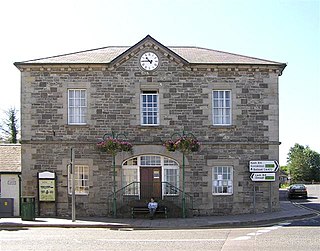
New Alresford or simply Alresford is a market town and civil parish in the City of Winchester district of Hampshire, England. It is 7.5 miles (12 km) northeast of Winchester and 12 miles (20 km) southwest of the town of Alton.

The Hazlitt Theatre and Exchange Studio, also known as the Hazlitt Arts Centre, is a theatre complex in Earl Street in Maidstone, Kent, England. The oldest part of the complex, which is now used as a shopping complex on the ground floor, and as a theatre venue known as the "Exchange Studio" on the first floor, is a Grade II listed building.

Wootton Bassett Museum is a local museum in the market town of Royal Wootton Bassett, Wiltshire, England. It is housed in the town hall which is a Grade II listed building.

Market House is a municipal building in Conway Square, Newtownards, County Down, Northern Ireland. It is a Grade B+ listed building.

Romsey Town Hall is a municipal building in the Market Place in Romsey, Hampshire, England. The structure is the meeting place of Romsey Town Council.

Saffron Walden Town Hall is a municipal building in the Market Place, Saffron Walden, Essex, England. The structure, which is the headquarters of Saffron Walden Town Council, is a Grade II listed building.

The Old Town Hall is a municipal structure in Scarva Street in Banbridge, County Down, Northern Ireland. The structure, which currently accommodates a Community Advice Centre on the ground floor and a room for local community groups on the first floor, is a Grade B1 listed building.

Camelford Town Hall is a municipal building in the Market Place, Camelford, Cornwall, England. The town hall, which is currently used as a public library, is a Grade II listed building.

Garstang Town Hall is a municipal building in the High Street in Garstang, Lancashire, England. The structure, which currently accommodates two shops and a Royal British Legion Club, is a Grade II listed building.

Dulverton Town Hall is a municipal building in Fore Street in Dulverton, Somerset, England. The building, which is the meeting place of Dulverton Town Council, is a Grade II listed building.

Ederney Town Hall, also styled as Ederney Townhall, is a municipal structure in Market Street, Ederney, County Fermanagh, Northern Ireland. The structure, which is used as a community events venue, is a Grade B1 listed building.

Ballynahinch Market House, formerly known as Ballynahinch Court House and as Ballynahinch Town Hall, is a municipal structure in the Market Square, Ballynahinch, County Down, Northern Ireland. The structure, which is used as a community events venue, is a Grade B1 listed building.

Gosport Town Hall is a municipal structure in the High Street, Gosport, Hampshire, England. The structure currently serves as the headquarters of Gosport Borough Council.

The Market House is a commercial building in Church Street in Camborne, Cornwall, England. The structure, which is currently used as a hotel and public house, is a Grade II listed building.

The Corn Exchange is a commercial building in the Market Place, Kettering, Northamptonshire, England. The structure, which was used as a cinema for much of the 20th century, currently accommodates a restaurant.

The Corn Exchange is a commercial building in Broad Street, Stamford, Lincolnshire, England. The structure was refurbished between 2001 and 2008 and is now used as a theatre.

Lostwithiel Guildhall is a municipal building in Fore Street in Lostwithiel, Cornwall, England. The structure, which currently accommodates the local museum, is a Grade II listed building.

Milborne Port Town Hall is a municipal building in the High Street in Milborne Port, Somerset, England. The structure, which serves as meeting place of Milborne Port Parish Council, is a Grade II listed building.

Long Sutton Market House, also known as Long Sutton Market House and Corn Exchange, is a commercial building in Market Street in Long Sutton, Lincolnshire, England. The structure, which is now used as a community events venue, is a locally listed building.

The Old Town Hall is a municipal building in St Mary Street, Newport, Shropshire, England. The structure, which is now divided into a series of shop units on the ground floor and used as a children's play area on the first floor, is a Grade II listed building.





















